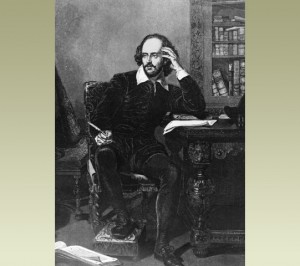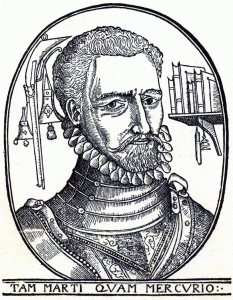
A (hypothetical) portrait of Shakespeare at his desk. It’s very possible that he would have worked with multiple popular texts to compose his own
To the reverent eyes of modernity, Shakespeare’s fame is infallible. His very name has almost been chiseled into a byword for literary genius, and accords a respect approximately proportionate to say, Einstein in terms of the sciences. Yet, simple investigation often shocks readers when they discover that Shakespeare’s plays are often, on the schematic surface, markedly derivative of prior cultural productions. Often lifting or borrowing entire plots and characters, Shakespeare’s plays skirt towards imitation, superficially at least, to a degree that would furrow the brows of modern-day anti-plagiarism culture. The instinctive reaction can be disillusionment. Entire visions of romantic inspiration shatter when any adequate glossary explains that Shakespeare’s Romeo and Juliet is a rehashing of a popular tale, and a contemporary poem The Tragical History of Romeus and Juliet (the companion edition of G.B. Harrison, in my case). Measure for Measure is no exception to this practice. Yet dissecting the inspirations, influences and derivations is not necessarily to abolish Shakespeare’s genius, or dramatically rip the mask from literature’s idol. Instead, as critical analysis has long accepted, detecting Shakespeare’s sources only contextualizes his plays, not as spontaneous innovations, but as deeply imbedded in a society chafed by rapidly modernizing views of injustice, yet festering with crime proportionate to unprecedented urbanization.
In his article on the sources of Measure for Measure, academic Charles Prouty traces the lineage to Shakespeare’s play through a society more accepting of inter-textual adaptation. He even quotes a contemporary of Shakespeare as saying, “[a]nd truly it should be a great miserye to stoppe without wading further then almost the first that ever wrote” (145). In this cultural paradigm, adopting and revamping previous productions is “wading further” and not invasive plagiarizing. This practice succeeds from classical tradition, as the ancient poets of antiquity endeavored to adapt and comment on existing literature and legend. Prouty cites as Shakespeare’s greatest influence George Whetstone’s Promos and Cassandra (1571), a two-part “comedy” play. Though his name hardly carry the cachet of Shakespeare’s currently, Prouty maintains that Whetstone was perhaps the chief poet of Marlow’s and Shakespeare’s youth, so presumably his works would have been foregrounded in Shakespeare’s cultural exposure (144). Whetstone’s work was, in turn, probably derived from Italian writer Cinthio’s posthumous (and translated) novella Epitia, or other versions of the same tale, and thus represented another rung in the Renaissance tradition of reworking existing popular literature.
So when Shakespeare replicated the outline of Promos and Cassandra, he wasn’t cheaply pilfering ideas to generate revenue, but rather was grappling with prevalent social ideas, in a practice far more accepted and established in his time. And Prouty notes some ostensible innovations of Whetstone’s versions that must have begged the social questions of justice, crime, and lust that Shakespeare’s own play engages. Prouty dutifully details Whetstone’s own artistic occupation with the underbelly of society that had been shunned in previous chivalrous or elitist renditions: “Whetstone was giving to the world a first- hand account of the low-life of London which he had known through personal experience “(134). By depicting justice as pertaining and reaching to the common, the vulgar of society and not just the storied confines of courtly law, he cued Shakespeare to extend his own staging into the slums and brothels that were increasingly a preoccupation of Elizabethan society.
Furthermore, Whetstone chooses to set his play in the city of “Julio”, most likely a city in eastern Hungary. He names and models the authority figure in his paly after the renowned Hungarian King Corvinus (aka. Matthias Hunyadi), a Hungarian king whose conquests expanded into Bohemia and Prussia, and who was reputed for his impartial, magnanimous rule. So great was Corvinus’ reputation, that following his death a proverb lamented his demise: “Mathias is dead and justice is fled the world”. Whetstone’s play then invokes a paragon of Renaissance justice, which Shakespeare very deliberately edits. This is an important detail, since Vincentio and Angelo are then implicitly reflections, or shadow commentaries, on this exemplar of justice that they certainly fail to meet. Such distinctions are unfortunately lost on a crowd that insists on Shakespeare as an insular production. Astute academic argument would note that Shakespeare refuses to accept or entirely trust this popular template for justice.

Elizabethan writer George Gascoigne had stints as both a soldier and a lawyer. Like Whetstone, he failed to fully enter courtier society.
Ultimately, however, constructions of intertextuality as purely linear can only go so far, and Prouty notes this. The popular book The Glasse of Government (1571), by Whetstone’s contemporary and friend George Gascoigne, proves to be likely inextricable in the formation of Whetstone’s play, and by extension Shakespeare’s. Though it is not directly a template for the story in Measure for Measure, Prouty recounts the harsh, relentless administration of justice in Giasgow’s book that is conspicuously absent in Whetstone’s play yet so prevalent in Shakespeare’s. This tangles the notion that each artist interacted with a direct inheritance, and refutes the notion of artistic independence as nearly untenable. It seems more likely that Shakespeare had a desk or a head cluttered with prior sources when composing his own play. This convolution balloons further when Prouty alludes to other more influences on the story, almost too obscure to develop or prove. Over two dozen potential sources exist, some dating all the way back to St. Augustine, whose Latin writings would have been abundantly familiar to a student Shakespeare.
(For more detailed, read Charles T. Prouty’s article “George Whetstone and the Sources of Measure for Measure”. All page numbers and facts refer to his article in Shakespeare Quarterly. Click links for more thorough biographies of Whetstone and Gascoigne)
